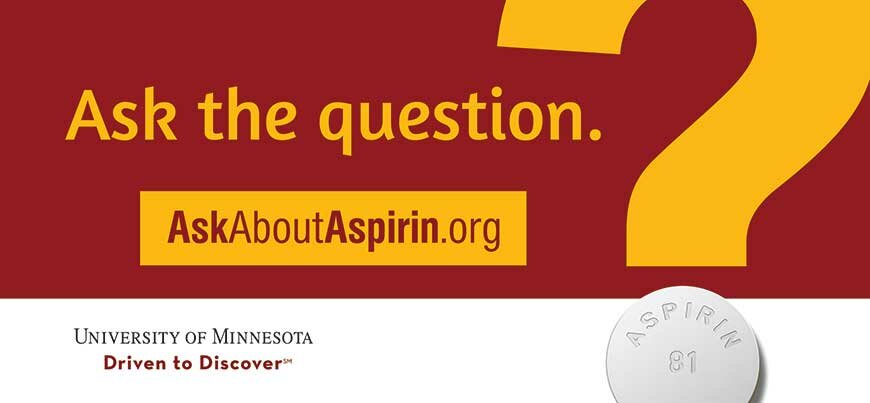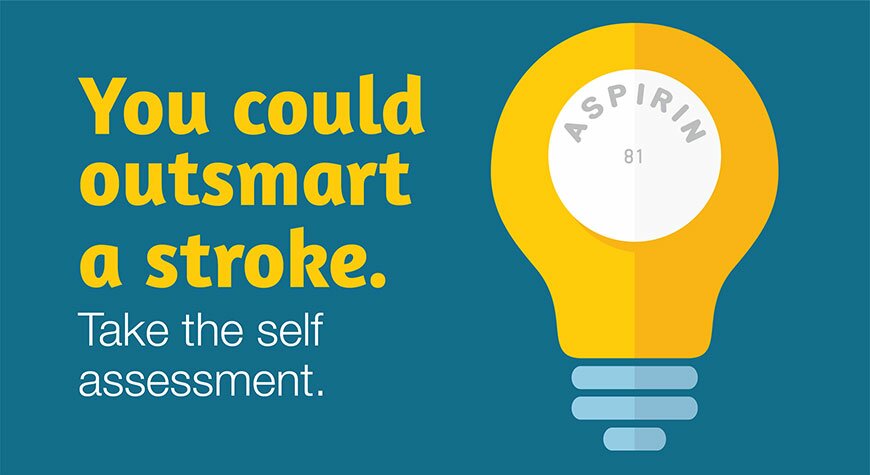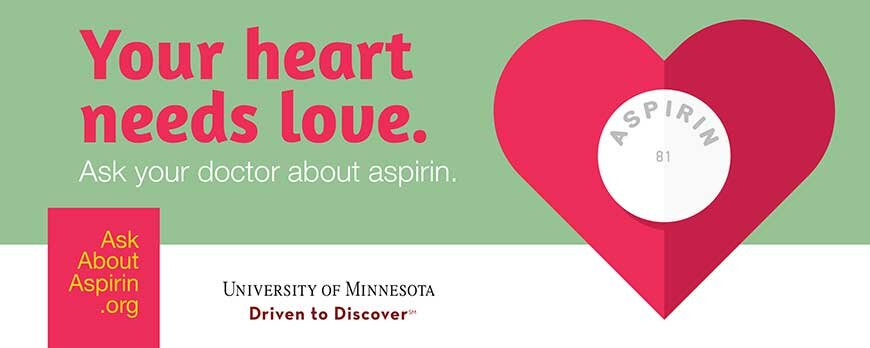Ask About Aspirin
A Case Study on the
Minnesota Heart Health Program’s
Aspirin-Based Cardiovascular Disease Prevention Initiative

-
Acknowledgments
-
The Minnesota Ask About Aspirin team is deeply grateful to Dan Garry, MD, PhD, and the Lillehei Heart Institute for its generous philanthropic funding. We are also thankful for our partnership with the Minnesota Department of Health, whose support has been key to the success of the Ask About Aspirin initiative. We would like to acknowledge our Community Advisory Board for its advocacy and support, including: the American Heart Association, American College of Cardiology, Minnesota Chapter, Institute for Clinical Systems Improvement, Minnesota Academy of Family Physicians, Minnesota Community Measurement, and the Minnesota Medical Association.
-
-
Foreword
-
Aspirin is a remarkable drug. Each year, researchers publish hundreds of new scientific studies about aspirin and its benefits. Derived from the bark of the willow tree, it has long been known to fight pain and reduce fevers. Although very inexpensive, aspirin can also prevent heart attacks, strokes, and certain kinds of cancer. While not everybody should take aspirin, this effective drug is known to be under-used in people who would benefit from it. To this end, Altarum Institute and its Council on Aspirin for Health and Prevention urge federal, state and local health leaders to provide consumers and health care professionals with science-based information to improve the appropriate use of aspirin to promote good health.
The Minnesota Heart Health Program, created and operationalized by the University of Minnesota’s Lillehei Heart Institute and School of Public Health, is doing just this—and doing it well. The Ask About Aspirin initiative is an excellent model of how a public university and state partnership can provide regional and national leadership in population-focused disease prevention. What is unique about this particular, well-crafted public health intervention is the clarity with which the science base has been translated into definitive and effective strategies. While the Minnesota Heart Health Program has been setting such standards for over 30 years, their ongoing leadership has demonstrated methods that foster the appropriate daily use of low-dose aspirin to achieve improved cardiovascular health. The program is a public health campaign, a major clinical investigation, and a collaborative effort of this land grant state university, the Minnesota Department of Health, other Minnesota health advocacy organizations, public health agencies, and collaborating health systems.
Altarum Institute and the Council on Aspirin applaud the leaders in Minnesota who conceived and implemented Ask About Aspirin, and we developed this case study to educate stakeholders nationwide about aspirin and prevention.
David Zauche
Senior Program Manager
Altarum Institute Kathy Berra, MSN, NP-BC, FAAN
2015 Chair
Council on Aspirin for Health and Prevention
-
-
Background
-
 University of Minnesota Banner
University of Minnesota Banner
Since its inception 35 years ago, the Minnesota Heart Health Program (MHHP) established a strong tradition of creating partnerships to improve cardiovascular health across the state and nation. In 2012, the MHHP launched the Ask About Aspirin initiative. The goal was to support the State of Minnesota “Heart Disease and Stroke Prevention Plan: 2011–2020” (16k PDF) by lowering the number of first heart attacks and strokes by promoting appropriate use of low-dose aspirin. The Ask About Aspirin initiative is designed to ensure that an informed public can engage informed primary care health professionals to determine individual aspirin use candidacy. Then, the individual benefit and risk of low dose aspirin use, considering patient preferences, can be professionally evaluated before aspirin is prescribed. The initiative has created a public media intervention (using both traditional and digital media tools) and health professional educational tools to disseminate these aspirin-focused cardiovascular disease prevention messages. Ask About Aspirin supports the recommendations of the U.S. Preventive Services Task Force, the Centers for Disease Control, the American Heart Association and the Minnesota Department of Health.
The Ask About Aspirin initiative is designed to achieve the nation’s “Triple Aim”: to sustain individual health, to promote community health, and to lower the economic burden of preventable cardiovascular disease. It was designed by the faculty of the Lillehei Heart Institute at the University of Minnesota Medical School, in partnership with the School of Public Health. It is an official partner of the U.S. Department of Health and Human Services Million Hearts® initiative. The initiative is linked to ongoing scientific support and advocacy via a community advisory board that includes key stakeholders, such as the Minnesota Department of Health, Minnesota Medical Association, Minnesota Academy of Family Physicians, Institute for Clinical Systems Improvement, Minnesota Community Measurement, American Heart Association, and the American College of Cardiology (Minnesota Chapter). Ask About Aspirin engages the broadest possible state leadership, creating formal partnerships with all key regional health systems. The initiative also collaborates with the Centers for Disease Control and Altarum Institute’s “Council on Aspirin for Health and Prevention”. In its current phase, the initiative is planned to run from May 1, 2015 to December 1, 2019.
-
-
Rationale and Goals
-
The goals of the Ask About Aspirin initiative are:
- Conduct research to explore public and health professional knowledge, attitudes, and behavior related to aspirin.
- Launch a campaign, focused both on consumers and health professionals, to promote best practices in aspirin use. Safely lower rates of first heart attacks and strokes.
- Facilitate clinically effective and cost-effective cardiovascular population health across Minnesota.
Multiple prospective randomized trials have proven that low-dose aspirin can lower the risk of a first heart attack or stroke. When candidates for aspirin use are selected carefully, the risks associated with aspirin use (bleeding in the stomach and brain) are low. Yet, in 2015, less than half of at-risk Minnesota adults use daily low-dose aspirin to lower their risk of a first heart attack or stroke. Appropriate primary prevention aspirin use has the potential to avert more than 10,000 first time heart attacks and strokes in Minnesota over five years.
The Ask About Aspirin initiative does not endorse general use of this anti-thrombotic medication, but provides a clearly defined focus on the target population that is at higher risk of a first heart attack or stroke per the 2009 U.S. Preventive Services Task Force (USPSTF) recommendations. Thus, initial candidates for appropriate aspirin use are men ages 45 to 79 years and women ages 55 to 79 years. From this candidate population, individual cardiovascular risk and potential aspirin use contraindications (including the risk of GI bleeding or other harms) is then considered by the individual and the primary care health professional. By facilitating this discussion, the program has created a unique infrastructure that fosters proactive aspirin use, as defined by the USPSTF, and also by the Minnesota Department of Health, the American Heart Association, the American Diabetes Association, and the American College of Cardiology. Prior to the Ask About Aspirin initiative, it was challenging for patients or their physicians to rapidly determine whether aspirin therapy for primary prevention, even within a high cardiovascular risk population, would be associated with benefits that would outweigh the potential harms. This challenge has been magnified recently by the incredibly fast pace of most primary care office practices. This process is now simplified and, thanks to the Ask About Aspirin tools, has been shown to be practical for use in daily practice.
Most community risk-reduction studies are designed to address multiple modifiable cardiovascular disease risk factors, such as tobacco use, diet, exercise, hypertension, and cholesterol. These other approaches to risk reduction are therefore challenging. In contrast, there are no other interventions that can reduce cardiovascular disease morbidity and mortality through the promotion of a single pharmacologic approach, such as aspirin.
Ask About Aspirin’s desired action on the part of the public is for men and women in the targeted age groups to ask their health professional if they should take aspirin. The action desired on the part of health professionals is for them to evaluate their patients as potential aspirin candidates and recommend daily, low-dose aspirin therapy to those individuals for whom it is appropriate. These health professionals include family physicians, internal medicine physicians, physician assistants, nurse practitioners pharmacists, and medical assistants. Thus, this initiative was designed to ensure that essentially all practitioners who engage the patient in a primary care setting are well-informed about how to best use aspirin effectively and safely.
The initiative is both a public health campaign, devoted to increasing aspirin use in the target population, and a major state-based clinical investigation. As an investigation, the faculty have evaluated baseline aspirin use in the state population to define the “prevention gap” in appropriate aspirin candidates. It has also defined the “over-treatment challenge” that may exist when aspirin is used inappropriately. Numerous quantitative evaluations of the initiative have helped the staff continuously improve its operations. The efficacy of the public media campaign has been evaluated. The accuracy of public survey tools to assess aspirin use has been evaluated by biochemical testing. And the proposed clinical efficacy and health economic impact of the program have been modeled to ensure that the Triple Aim might be achieved. Process measures are actively monitored to determine the relative efficacy of each key intervention (public media campaign, social media messaging, and health system interventions). This knowledge is critical to maximize program efficacy and to ensure that an effective Minnesota aspirin campaign could be easily scaled and disseminated nationally. This population interventional approach is also designed to serve as a base for other cardiovascular public health campaigns that would utilize these tools over the decade ahead.
-
-
Formative Research
-
The focus groups and survey also asked specifically about aspirin and aspirin use. From participant responses, it was learned:
- 78% believed taking aspirin has advantages and only 3% believed that aspirin use has disadvantages.
- 75% reported that one should only take aspirin if recommended by a doctor.
- 95% said their doctor could convince them to take aspirin.
- 82% believe there has been plenty of research on taking aspirin as a preventive measure.
- 58% believe that aspirin is safe.
- Of those taking aspirin for cardiovascular prevention, 79% take low-dose aspirin.
Before the launch of the Ask About Aspirin initiative, the University of Minnesota engaged a study performed by Padilla Speer Beardsley (a public relations and marketing firm) that conducted focus groups and surveys to inform program development. The purpose of the study was to measure knowledge, attitudes and behavior of both the general public and health professionals in Minnesota related to the use of daily aspirin to prevent a first heart attack and stroke. The results of the research were used to inform the initial aspirin strategic message development and tactical campaign execution. It was determined that the public was favorable to use of aspirin to prevent a heart attack or stroke, but that individuals did not know how to determine if they were candidates. Similarly, physicians were knowledgeable that aspirin could be a useful prevention medication, but were not confident they could easily identify when benefit would exceed potential harm in their patients. These data identified the communication preferences of the aspirin target audiences to pinpoint how and where to allocate campaign resources.
The public focus groups indicated that the three primary media sources on which potential aspirin candidates rely are television, websites and printed newspapers. Almost 50% also regularly listen to radio and about 30% regularly read online newspapers. For health care information, however, 75% of survey respondents said their doctor is their main source for health information and 71% reported that they sought that information online. A large fraction of the public noted that their main source of health information included talking with friends and family, television, printed newspapers and magazines.
-
-
The Hibbing, Minnesota, Pilot Study
-
 University of Minnesota Banner
University of Minnesota Banner
Creating a large statewide primary prevention program is associated with many challenges. In order to ensure that program tools were effective, the northern town of Hibbing, Minnesota, was selected to evaluate the community-based intervention. The city has a population of approximately 16,000, is predominantly white, has a median age of 43 years, a median household annual income of $38,000, and 28% of its residents are college graduates. It is representative of other Minnesota municipalities, but may be more racially homogenous than other small cities outside the Midwest. Three competing area health systems offer primary care to this community.
The University of Minnesota team had conducted focus groups that defined aspirin knowledge and attitudes from both the public and primary care physicians. This information was used to inform the development of the dual public and health system interventions. The public media campaign was designed to use simple messages created to inform the individuals to consider their personal cardiovascular risk and then to ask a health professional if they should use aspirin. The public was also provided access to self-assessment tools so individuals could easily identify whether or not they were a potential primary prevention aspirin candidate. If so, they were then encouraged to discuss aspirin use with a health professional. These self-assessment tools were made available both on the program website and via mobile (cell phone) devices. The public was also provided with easy access to other sources of information on appropriate aspirin use to prevent heart attacks and strokes via brochures that were distributed to primary care clinics, pharmacies, libraries, and work sites. The second intervention was designed to engage all primary care health professionals, individually and as clinical teams, so that uniform and accurate prescriptive advice would be provided to aspirin candidates. Every primary care health professional was asked to complete a 30 minute continuing medical education-certified training session so that the rationale, benefit, and risk of aspirin use would be known. Each professional completed a pre-test and post-test to ensure that this information was accurately learned. After completion of these sessions, the health professionals were provided with a series of clinic-based tools to foster appropriate aspirin use including aspirin candidacy pocket cards and either manual or electronic health record tools to identify candidates (e.g., best practice alerts). The Hibbing aspirin primary prevention intervention also created a series of local partnerships with community organizations intended to improve the awareness of the campaign within city leadership.
The Hibbing program was a major success. Population-based aspirin use was measured before and at two time points (at 4 and 16 months) after this community-based intervention. The phone surveys of randomly selected residents in the target population (men ages 45-79 and women ages 55–79 years) accurately defined aspirin use, as the study metrics demonstrated that self-reported aspirin use was almost universally associated with biochemical confirmation of suppressed thromboxane B2 levels (a superb marker of aspirin exposure).
At baseline (pre-campaign), 36% of the primary prevention candidates reported regularly using aspirin, which is comparable to the national average. At 4 months after campaign initiation, daily aspirin use in the Hibbing community population had increased to 54%. This higher aspirin use rate was sustained at 52% at the 16 month mark. Additionally, at the 4 month time point 46% of primary prevention candidates, and at 16 months 63% of candidates, indicated they had seen or heard the program messages in their community or workplace. When asked to identify their reasons for initiating aspirin use, most primary prevention candidates who took aspirin regularly to prevent a heart attack or stroke did so in response to a recommendation by their health care provider (68% at 4 months, 71% at 16 months). The next most common reason was response to media advertisements (66% at 4 months, 46% at 16 months). Older individuals were more likely to use aspirin use at all three time points.
The Hibbing program was designed to ensure that an informed, high-risk individual would seek advice on appropriate aspirin use from an informed primary care health professional. This was achieved. Discussions about aspirin use initiated by health care providers were shown to increase among primary prevention candidates, but this increase was not significant in a small sample (12% at baseline, 19% at 4 months, 22% at 16 months). Nevertheless, regular aspirin users were significantly more likely than non-regular aspirin users to have had discussions about aspirin use with their health care provider at 4 months.
The Hibbing pilot study suggests that community-based interventions may provide the greatest benefit for those aged 45 to 64 who are at higher risk of heart attack and stroke, but who may not consider themselves to be at risk. Furthermore, regular aspirin users had a more favorable attitude toward aspirin use and they were more likely to perceive aspirin use as a common behavior in their social network. This latter finding supports the importance of influencing social networks to increase appropriate aspirin use. The study also re-confirmed that cardiovascular disease (CVD) interventions are most effective when there is involvement of both health care and non-health care public and private community partners. These partners serve as either intervention facilitators or as effective reinforcers of CVD prevention messages. Public media campaigns also support the efficacy of such primary care aspirin initiatives by encouraging the public to initiate aspirin-related discussions with their health care professionals. Health care professionals then play a strong role in helping evaluate individual benefit and risk, and they ensure that individual patient values are considered during the process of deciding whether to use aspirin as a primary prevention intervention.
-
-
Expanding to a State-based Preventive Intervention
-
Following the Hibbing pilot, a statewide public media campaign was launched to promote the importance of appropriate primary prevention aspirin use among the USPSTF-defined high risk candidates: men ages 45–79 and women ages 55–79 years. Award-winning media messages are being disseminated via billboards and digital media (online advertisements on Facebook and Twitter), and in-clinic communication strategies are being used to promote the importance of the appropriate use of aspirin for primary prevention of cardiovascular disease.
 University of Minnesota Brochure
University of Minnesota Brochure
-
-
Primary Prevention as a System-Based Quality Improvement Initiative
-
 University of Minnesota Poster
University of Minnesota Poster
All Minnesota health systems and primary care practices are now being encouraged to implement the Ask About Aspirin program as a quality improvement (QI) initiative. Minnesota health systems already actively measure aspirin use for secondary prevention as an established quality improvement initiative. The Ask About Aspirin initiative leverages this work to help these systems rapidly integrate the Grade A USPSTF aspirin primary care recommendations into their daily practice. The health system QI initiative includes a variety of practice tools that can be used to support effective practice improvement. Participating primary care clinics and health systems will determine the best way that the QI initiative should be implemented. The University of Minnesota has offered these systems access to aspirin-trained practice facilitators to assist these clinic-based QI efforts. Other aspirin-related practice improvement tools, available free of charge, include: a short “state of the art” web-based CME-accredited learning module; informational patient brochure; a “Guideline for Assessing Candidacy for Daily Aspirin Use” pocket card (241k PDF); an electronic health record aspirin candidacy tool (65k JPG), and a web-based risk calculator to help providers determine whether primary prevention aspirin use is recommended for a patient. Calculations are based on the most recent United States Preventive Services Task Force recommendations. Additionally, the University of Minnesota created a succinct aspirin primary prevention clinician information sheet (2-page 572k PDF) that informs clinicians about the evidence-based guidelines for aspirin use for the primary prevention of heart attacks and strokes.
-
-
Website
-
 University of Minnesota Website Banner
University of Minnesota Website Banner
The Ask About Aspirin initiative website provides the public with background on the program, its sponsors and partners, information about how aspirin achieves its beneficial effects, and includes short informational and testimonial videos. A self-assessment tool that helps consumers consider aspirin use and encourages them to speak with their physician is also available on the site at www.askaboutaspirin.org.
-
-
The Future of Ask About Aspirin
-
 University of Minnesota Billboard
University of Minnesota Billboard
In summary, aspirin rates for the primary prevention of cardiovascular disease in Minnesota remain low, and this rate is similar to rates measured in other states. Increasing appropriate aspirin use among a high-risk target primary prevention population per USPSTF guidelines could reduce cardiovascular disease, and likely achieve these benefits cost-effectively. A combined public and primary care health system approach has been designed as a community-based intervention to achieve improved cardiovascular public health. The Ask About Aspirin initiative is designed to create large scale preventive engagement rapidly and to increase and sustain aspirin primary prevention use rates with measurable results.
To this end, the Ask About Aspirin initiative will continue to work with health systems across Minnesota to implement clinic-based interventions that will increase appropriate aspirin use in the state population. The initiative will also continue to implement a mass media campaign to inform the public about their cardiovascular disease risk, so that appropriate aspirin use candidates are encouraged to ask their health professional if aspirin is right for them.
Rarely are such large state-based primary prevention efforts so tightly linked to objective measurement of program efficacy. The Minnesota Heart Health Program has secured National Institutes of Health (National Heart, Lung, and Blood Institute) funding to support such an evaluation. Using a two-arm design, 24 Minnesota geographic areas will form the basis for a group-randomized trial that will precisely define the utility of the public media campaign and health system primary care interventions. State rates of heart attack and stroke, as well as gastrointestinal bleeding, will be measured. Finally, the health economic impact of the program will be prospectively measured.
This deep and careful evaluation is significant. The nation has had proof of aspirin-based primary prevention efficacy for over twenty years, but until now there has been no effort to efficiently translate this knowledge into real world practice change. The Ask About Aspirin initiative is designed so that program elements, once fully tested and assessed, can be utilized outside of Minnesota to benefit the nation. Within 3 years, the impact of Ask About Aspirin will be clearly defined. Prevention is something valued by the public and prevention efforts are core to a healthy population. Appropriate aspirin use can play an important role in this effort.
-
-
References
-
Minnesota Heart Disease and Stroke Prevention Plan: 2011-2020 (1.1MB PDF)
Oldenburg NC. Duval S. Luepker RV, Finnegan JR, LaMarre H, Peterson KA, Zantek ND, Jacobs G, Straka RJ, Miller KH, Hirsch AT. A 16-Month Community-Based Intervention to Increase Aspirin Use for Primary Prevention of Cardiovascular Disease. Preventing Chronic Disease, 2014 May 15;11:E83. doi: 10.5888/pcd11.130378
Zantek ND, Luepker RV, Duval S, Miller K, Oldenburg N, and Hirsch AT. Confirmation of Reported Aspirin Use in Community Studies: Utility of Serum Thromboxane B2 Measurement. Clin Appl Thromb Hemost, 2014 May;20(4):385-92.
Luepker RV, Steffen L, Duval S, Zantek ND, Xiao S, Hirsch AT. Population trends in aspirin use for cardiovascular disease prevention 1980-2009: the Minnesota Heart Survey. J American Heart Assoc, published in December 2015.
Tzeyu LM, Jalal H, Abraham J, Luepker RVL, Duval S, Hirsch AT. Cost-Effectiveness of a Statewide Campaign to Promote Aspirin Use for Primary Prevention of Cardiovascular Disease. J American Heart Assoc, published in December 2015.
-
-
Appendices
-
-
Minnesota Heart Disease and Stroke Prevention Plan—Aspirin Objective (16k PDF)
-
Guideline for Assessing Candidacy for Daily Aspirin Use—Pocket Card for Clinicians (41k PDF)
-
EHR and Clinical Decision Support Tool—Screen Shot (65k JPG)
-
Clinician Information Sheet (2-page 572k PDF)
-
Minnesota Medicine Article (174k PDF)
-
Heart Insight Article (168k PDF)
-
-
 Download a PDF version of the report: ASK ABOUT ASPIRIN, A Case Study on the Minnesota Heart Health Program’s Aspirin-Based Cardiovascular Disease Prevention Initiative (13-page, 2.1 MB PDF)
Download a PDF version of the report: ASK ABOUT ASPIRIN, A Case Study on the Minnesota Heart Health Program’s Aspirin-Based Cardiovascular Disease Prevention Initiative (13-page, 2.1 MB PDF)

